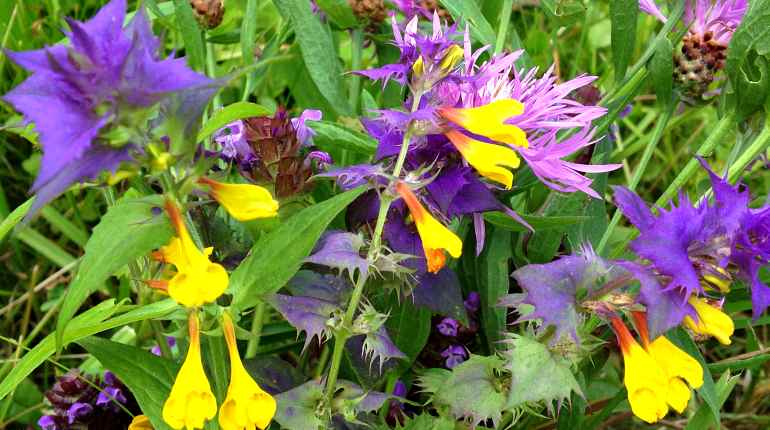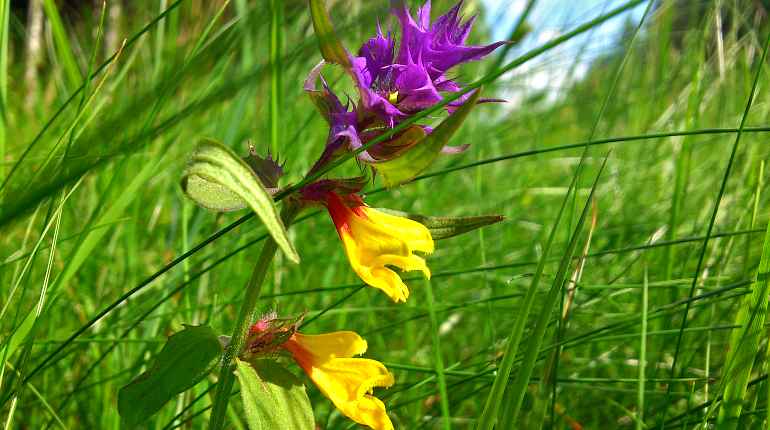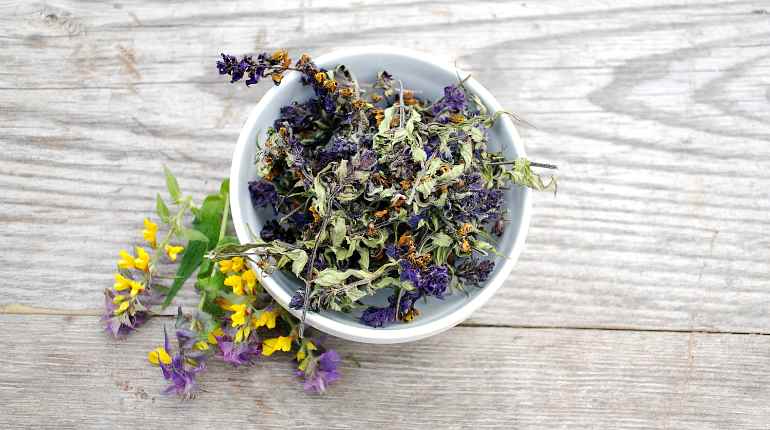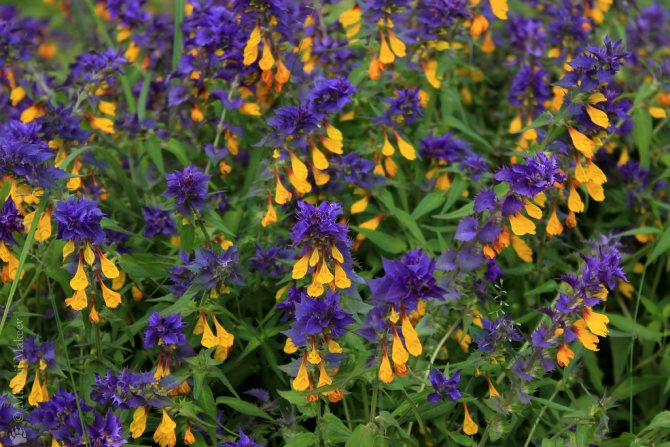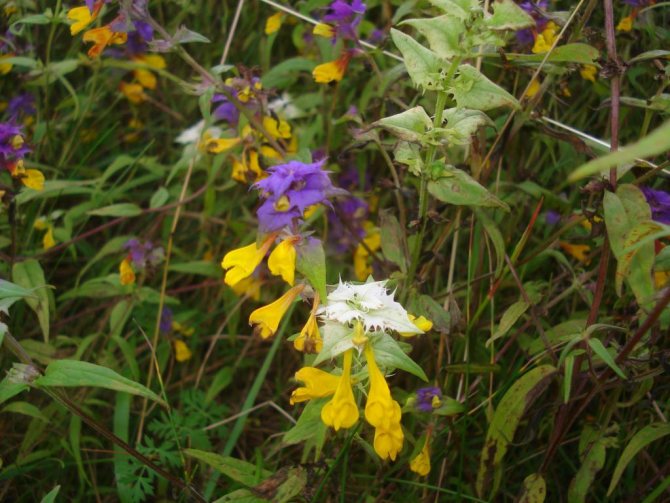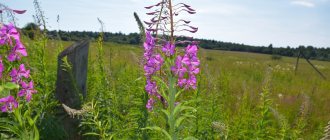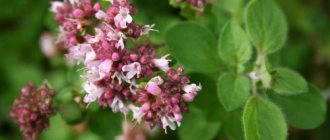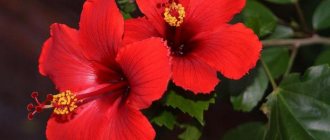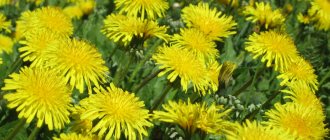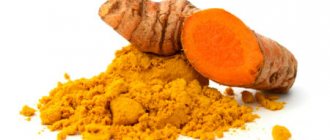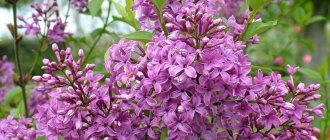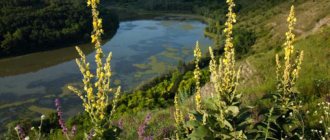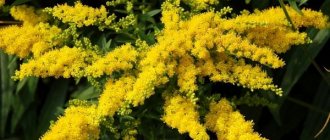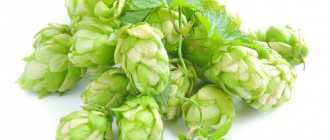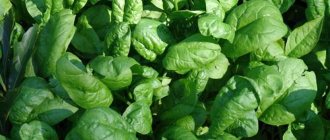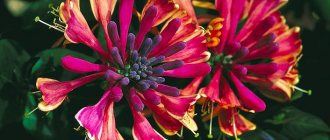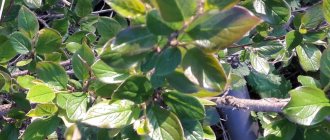We will use here and further names rather folk than strictly botanical. Popular names: Mariannik Dubravny
- ivan-da-marya, ivanets, ivanova grass, mariannik, brother and sister, pansies, bicolor, yellowberry, scrofulous grass, fireflower;
Meadow beetle
- Peter's grass, magpie shavings, cornflowers, kusharka, lucrose, jaundice;
forest mariannik
- oppression, mare's grass;
field mariannik
- vertebra, zvonets, ivan-da-marya, yellowhead, field grass.
General information about the Ivan da Marya plant
Mariannik Dubravny (Melampyrum nemorosum L.) is an annual herb with a pubescent stem. Leaves are opposite, ovate-lanceolate. The flowers are light yellow, two-lipped, collected in spike-shaped inflorescences. The fruit is an ovoid capsule. Seeds are large, oblong, brown or almost black. Plant height - 15-60 cm.
Photo by L. Golovneva - Mariannik Dubravny, variety
The plant stands out with a particularly bright contrast between the bracts of blue tones and bright yellow corollas. It is very decorative, therefore it often attracted the attention of painters and poets, but what is torn into bouquets quickly fades. Flowers of Ivan da Marya abundantly emit nectar and are deservedly considered a good honey plant.
The name Ivan da Marya in different areas can be given to several (different) herbaceous plants, the flowers of which (or the upper parts of the entire plant) are distinguished by the presence of two sharply distinguishable colors, most often yellow and blue or purple. Most often, the word Ivan-da-Marya is called the oak tree, less often - the tricolor violet. Even less often, such a name is given to meadow sage and periwinkle - they also have brightly different two colors.
Mariannik oak is found in the northern, middle and southwestern zones of the European part of Russia. It grows in forest clearings (sometimes in large tracts), forest edges, hills, in thickets of bushes, on swampy meadows and chalk slopes. The most common plant in our meadows, glades and edges of deciduous forests, where it blooms from late spring to early autumn (May-September).
In our zone there are five types of mariannik: mariannik dubravny
(M. nemorosum L.);
field mariannik
(M. arvensis L.);
mariannik meadow
(M. pratense L.);
forest mariannik
(M. silvaticum L.) and
cut-up mariannik
(M. laciniatum Kosh).
In the photo - Mariannik meadow
In the photo - Forest Maryannik
The most common marianniki: meadow and cut. Mariannik meadow is very similar to Ivan da Maryu, but only it has no purple leaves, and the flowers are almost white. This type of mariannik is characteristic of coniferous forests, although it has the specific name "meadow".
In the photo - Mariannik field
Healing recipes
Recipes for medicinal infusions have come from ancient times. The main thing in the recipe is to observe the accuracy of the ingredients introduced so as not to harm the body.
Tincture for the treatment of skin diseases: 3 tablespoons of dry herbs are brewed with boiling water (1 liter) and infused for 1.5–2 hours. Add to baths, wipe problem areas. Herbal lotions help with scabies mite, soften tumor neoplasms.
In case of heart failure, increased heartbeat, frequent dizziness, the initial stage of epilepsy and high blood pressure, a more concentrated infusion is prepared.For the same amount of herbs, take a glass of boiling water and insist. It is taken twice a day, half the dose after meals.
A decoction for hypertension: 15-25 g of dry herb pour 200-250 ml of water and heat in a water bath. Bring to a boil and keep for 30-40 minutes. Clean from grassy inclusions, add boiling water to the original volume. Break the daily intake into several times. Drink one tablespoon at a time. Also, this infusion is taken orally, 150 ml in the morning and in the evening with a mild stage of epilepsy. It helps to relieve convulsive syndrome, increased excitability.
With a nagging pain in the heart caused by vasospasm, alcohol tincture is used from mariannik. Combine 1.5 large tablespoons of dry grass with 0.5 liters of vodka or alcohol of 40% strength. Insist 14-16 days in a dark place, shake occasionally. The course of treatment is designed for 14–20 days: 15–20 ml before each meal. Then take a break for at least 1 week and repeat.
Ivan da Marya, like all medicinal plants, has a complex chemical composition. Before using for medicinal purposes, you should carefully read the instructions and possible side effects. Each disease has its own dosage and method of administration. The plant is not a panacea, but in combination with medications it gives a good result.
It so happened that many have heard of the Ivan da Marya flower, but few have any idea about it. But the contrasting beauty of this plant can become a highlight in any garden. And besides, the flower will be at hand if the need arises to take advantage of its medicinal properties. The article will help you understand the features of a medicinal plant, and the attached photos will allow you to enjoy the beauty of the flower.
Legends and traditions
Many legends associated with Ivan da Marya are dedicated to the symbolism of forbidden love. This is the tragic story of Kostroma and Kupala (Ivan and Marya), who fell in love without even suspecting that they were brother and sister. When they found out about this, Kupala threw herself into the fire (yellow flower of a plant), and Kostroma drowned herself (blue flower), after which they were reborn in the form of this plant. According to another version: Ivan-Kupala has a purple shirt, and Marya-Kostroma has a yellow kerchief. Previously, this herb was called Kupala da Mavka. (sometimes Navka, i.e. a mermaid - V.S.) - a drowned Kostroma who turned into a mermaid.
This story is directly timed to the Kupala holiday. It is on this day that the ivan-da-marya plant, which has special properties, is plucked.
Flower legends
Nature has endowed the ivan-da-marya plant with a very bright and contrasting color, therefore there are so many different legends and tales around it.
Each nationality tells its own legend of the appearance of a flower, but in each story there were lovers who, in spite of everything, wanted to be together. So this bright flower became a symbol of loyalty and love. Since ancient times, it was believed that blue is a masculine color, and yellow is a feminine color. But it is also not surprising that the name uses the most common Russian names - Ivan and Marya. They could symbolize any couple in love. The two most common legends are:
These are the amazing and interesting stories the people composed about this herb. But the flower became famous not only for its unusual legends, it also became famous for its healing properties.
Ivan da Marya (Maryannik oak tree) and its medicinal properties
The plant is poisonous. The internal use of marianniki, as poisonous plants, requires great care. It is known that the plant contains traces of alkaloids, glucoside melompikrit (dulcite), and in the seeds - a very poisonous glucoside rhinanthin (aucubin), which has a narcotic and local irritant effect. When poisoning with seeds, weakness, drowsiness is observed, and cardiac activity is weakened.
Poisoning of sheep and horses can be observed when they are fed with grain and flour, contaminated with seeds of the mariannik. Sick animals become drowsy, tremble, blood appears in their urine, and palpitations are noted. First aid consists in first prescribing laxatives, and then in conducting a course of symptomatic therapy (stimulants, cardiac, etc.).
Currently, Ivan da Marya is used only in traditional medicine.
Infusion of Ivan da Marya
Infusion of the herb Ivan da Marya is used as an effective remedy for baths and local washing in the treatment of various rashes, diathesis, eczema, skin tuberculosis, scabies, demodicosis, rheumatism. For the preparation of the infusion 3 tbsp. l. poured with 1 liter of boiling water and, having insisted for about 2 hours, filtered.
In the treatment of hypertension, dizziness, heart disease, neuralgia, epilepsy, diseases of the stomach and gastrointestinal tract, another infusion of mariannik is used. For its preparation 1 tbsp. l. herbs are poured with a glass of boiling water, then insisted for half an hour and, having filtered, take half a glass twice a day.
Decoction of fruits of Ivan da Marya
Decoction of fruits destroys harmful insects. Incl. can be used to disinfect the soil of indoor plants. Attention! The decoction of the fruits of this plant is poisonous.
Shredded parts of Ivan da Marya
With the help of fresh chopped herbs and its powder, the wound healing process (disinfection) is accelerated.
Application in traditional medicine
In folk medicine, aerial parts of this herb are used for the preparation of medicines:
- flowers;
- fruit;
- leaves;
- stems.
Beneficial features
The ivan da marya herb is a poisonous plant. Its entire terrestrial part contains glycosides and alkaloids, including dulcite and aucubin. Seeds are considered very poisonous.
They can cause quite severe poisoning in both humans and animals. Therefore, you need to carefully use the plant as a remedy. Despite this property, the plant has a healing effect in many diseases:
- So, its benefits are obvious in diseases of the stomach and gastrointestinal tract, heart (hypertension), as well as in neuralgia and epilepsy.
- It is especially effective to apply externally for skin tuberculosis, diathesis, scabies, rheumatism, various rashes, for washing wounds. Outwardly, you can apply powder from a dried plant, but also juice from a fresh one.
- Infusion of flowers has a calming, sedative, anticonvulsant effect. Tea from the plant is drunk with scrofula.
Potential danger
But you need to use the plant only according to the instructions, otherwise you can harm your health. The main symptoms of overdose, poisoning:
- stomach pain;
- weakness and drowsiness;
- vomiting and nausea;
- reduction in heart rate.
If a person is faced with the need to use this flower, then one should not forget about its toxic properties. Seeds are especially dangerous. They have a narcotic effect, cause drowsiness and irritability. If the above symptoms appear, you should consult a doctor.
Special and magical properties
It is believed that the magical properties of this plant, which was plucked on the summer solstice, is that it helps to get away from the pursuit of the one who keeps it with him. There is also a belief that a person who has this flower with him can drive fast even on an old nag. Previously, Ivan da Marya was carried with them by messengers and scouts (scouts). In addition, fresh juice squeezed out of this flower was allowed to drink to those who had lost their hearing or mind, memory, reason (Caution - the plant is poisonous - V.S.). Flowers of Ivan da Marya, collected at Kupala and kept in the house, protect the house from people with bad intentions, evil spirits (anti-demonic herb) and restore harmony between spouses. Flowers of this plant are placed in the corners of the house.This ritual also helps to protect the home from thieves.
Illustrations botanical
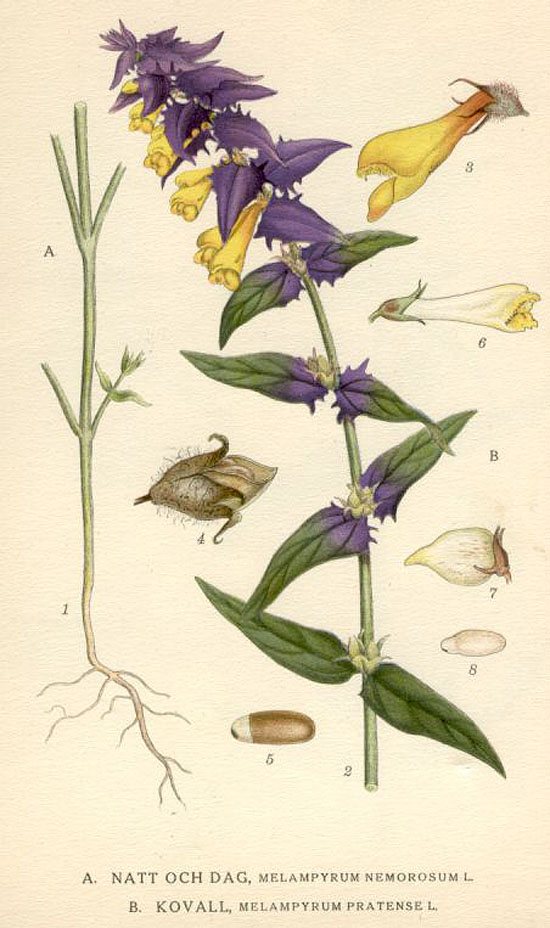
Maryannik Dubravny
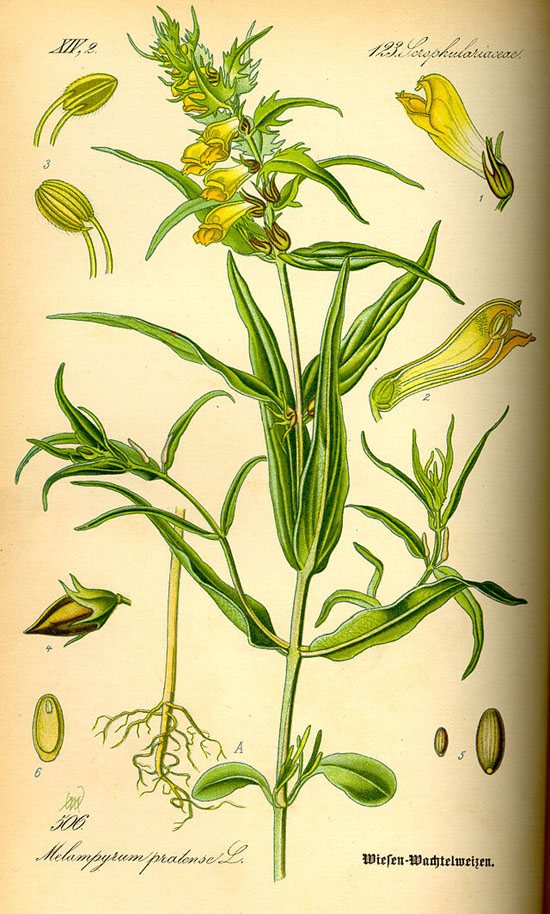

Mariannik meadow
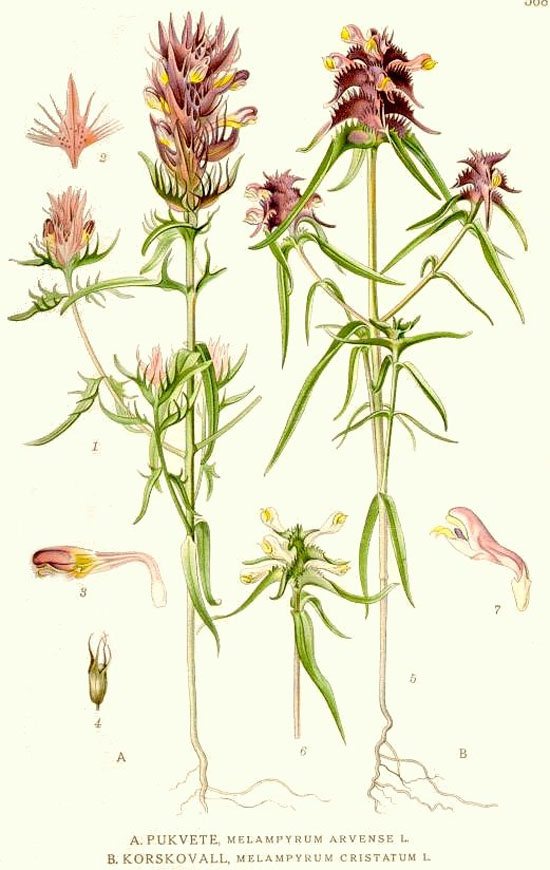

Field Maryannik
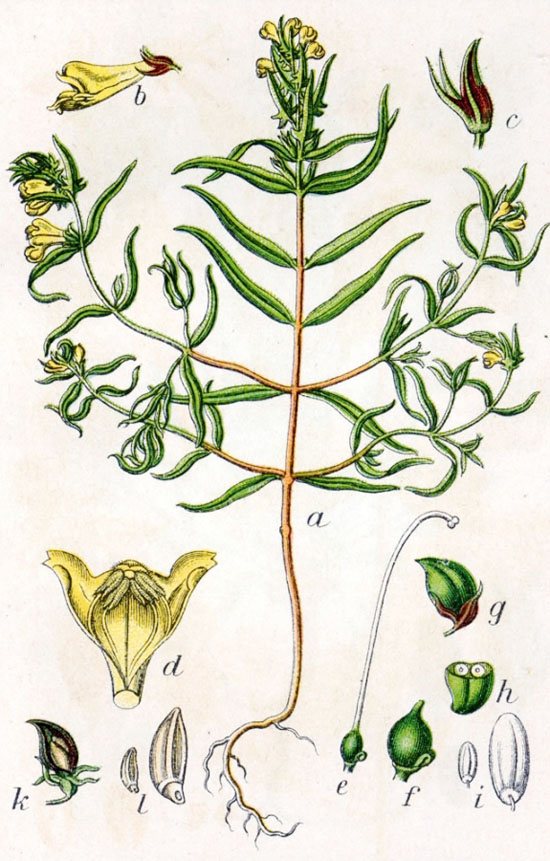

Mariannik forest
The plant Ivan-da-Marya (Mariannik oak tree) belongs to the genus Maryannik of the Zarazikhov family. It is also popularly called yellow jaundice, jaundice, tagged grass, lime trees, Ivan's grass, meadow bell. The Mariannik genus unites annual herbaceous plants that have an underdeveloped root system and an erect stem, reaching a height of 15 cm to 50 cm.
Mariannik blooms with bright yellow flowers from early summer to autumn, after which fruits appear on the plant in the form of bolls. The plant is very decorative, in addition, its flowers are a good honey plant. Some types of beetle, in particular, oak beetle, have long been used in folk medicine.
Application in traditional medicine
The use is justified in the treatment
:
- skin diseases;
- neuralgia;
- hypertension and dizziness;
- diseases of the gastrointestinal tract;
- heart disease.
Before using any traditional medicine, a doctor's consultation is required.
Several recipes for traditional medicine
In the treatment of skin diseases
3-4 tablespoons of herbs are brewed with 1 liter of boiling water
... After 2 hours, the infusion is filtered and added to the bath. Such a bath is effective for scabies, various rashes and diathesis.
When healing wounds and abrasions
A lotion of fresh finely chopped parts of the plant perfectly heals wounds and abrasions.
In the treatment of gastrointestinal diseases, neuralgia, dizziness, hypertension and heart disease
Use a decoction prepared in a thermos:
1 tbsp. a spoonful of dry grass is brewed with 1 glass of boiling water and insisted in a thermos for 30 minutes
... The broth is cooled, filtered and taken in half a glass 3 times a day. Taking the broth relieves joint and rheumatic pains, lowers blood pressure. When using a decoction, the dosage must be strictly observed in order to avoid accidental poisoning.
Use during pregnancy and lactation
Since the plant is poisonous, it is categorically contraindicated to use it for pregnant and lactating women. Taking drugs on the basis of Maryannik can harm not only a woman, but also a child.
.
Ivan da Marya - types and places of growth
Mariannik oak is a plant with a European range. The main places of its growth are the forest-steppe and forest European parts of Russia, the north-western and western forest-steppes of Ukraine, the Caucasus, Siberia. The best conditions for this plant are deciduous forests, chalky slopes and damp peat meadows.
In total, the genus mariannik has up to 35 species, among which the most characteristic of our zone are the mariannik oak (ivan-da-Marya), the mariannik field, the mariannik meadow, the mariannik forest and the mariannik cut.
Restrictions on use
As such, the plant has no contraindications, however, it should be remembered that in large quantities the Ivan da Marya plant is very poisonous. Accordingly, it is necessary to observe the exact formulation when making the decoctions.
Overdose symptoms are:
- dizziness;
- weakness;
- nausea and vomiting;
- drowsiness.
If the above symptoms appear, an urgent need to consult a doctor.
Often the name ivan da marya is used in relation to several different types of plants. Often this is the name of the meadow sage, and the tricolor violet, and the geneva tenacious, and the periwinkle, but the more famous plant is the oak mariannik. Its other names are Ivanets, bicolor or brother and sister.
This plant belongs to the broomrape family and is considered annual. The Ivan da Marya flower is a melliferous and ornamental plant, but at the same time it is poisonous. Despite this, it is widely used in traditional medicine.
Inflorescence - apical, brush - spike-shaped with a rare color. Bracts cordate-ovate, opposite, pointed with denticles, slightly pubescent along the veins and at the base. At the bottom of the inflorescence, the bracts are green, at the base of the middle part - violet-blue, at the top - purple.
The calyx is usually tubular with pointed denticles. The flowers of the plant are of irregular shape, the pedicels are small, turned to one side and pubescent. Corolla yellow, two-lipped, with a lower lip and a reddish tube. Blooms from May to September. It prefers to grow in oak forests, on forest edges and fields, in swampy meadows and among bushes.
The ivan da marya herb is widely distributed in European territory. The main habitats are forest and forest-steppe zones in the European part of Russia. But also the plant can be found in the Caucasus and Siberia, Ukraine. The best conditions for plant growth are peat and damp meadows, chalk slopes and deciduous forests.
The mariannik genus has 35 species. For Russia, the most typical species is ivan-da-marya (oak beetle), meadow, field and cut.
Ivan da Marya - medicinal properties
Ivan da Marya has anti-inflammatory, insecticidal and wound healing effects. In folk medicine, his decoction is used to treat diseases of the heart and stomach; use it for baths in the treatment of diathesis, eczema, skin tuberculosis, rheumatism. With the help of fresh crushed herb, the oak oak herb effectively heals wounds.
Interestingly, the people from ancient times have endowed the flowers of Ivan da Marya with special magical properties, believing that, collected on Ivan Kupala, they can divert evil influences from the house and keep good relations between the spouses.
Application
Ivan da Marya is not so much an ornamental plant as a medicinal one. It is used as:
- anti-inflammatory;
- healing;
- insecticidal.
The decoction is used to treat the following diseases:
- diathesis;
- eczema;
- scabies;
- lupus;
- rheumatism;
- epilepsy;
- wounds of various origins;
- heart problems;
- problems of the gastrointestinal tract.
Ivan da Marya - recipes
Infusion of the herb Ivan da Marya is used as an effective remedy for baths and local washings in the treatment of scrofula, various rashes and scabies. For its preparation 3 tbsp. l. poured with 1 liter of boiling water and, having insisted for about 2 hours, filtered.
In the treatment of hypertension, dizziness, heart disease, neuralgia, epilepsy, diseases of the stomach and gastrointestinal tract, another infusion of mariannik is used. For its preparation 1 tbsp. l. herbs are poured with a glass of boiling water, then insisted for half an hour and, having filtered, take half a glass twice a day.
With the help of fresh chopped grass and its powder, they accelerate the healing process, and with a decoction of the fruits, they destroy harmful insects.
Recipes
For the treatment of skin diseases such as scabies, eczema or diathesis, it is necessary to take baths with the herbal infusion. For the preparation of the infusion 3 tbsp. raw materials are poured with a liter of boiling water. Insist for 2 hours. Then it is filtered and poured into the bathroom with warm water. It is necessary to use the bath for about 30 minutes, 3-4 times a week.
Heart problems, dizziness, neuralgia, epilepsy, bowel and stomach diseases are treated with infusion according to the following recipe: 1 tbsp. raw materials are poured with a glass of boiling water. I insist 30 minutes in a thermos or in an insulated container. Strain and take half a glass several times a day.
For the treatment of open wounds, fresh, finely chopped grass Ivan da Marya is used. She is given a state of gruel and applied to the affected area.
Ivan da Marya - contraindications
When using the ivan-da-marya plant, it should be remembered that it is very poisonous, therefore, they should be used inside with great care.The seeds of the plant contain the poisonous glucoside rhinanthin (aucubin), which has a narcotic and local irritant effect, manifested by weakness, drowsiness, and weakening of cardiac activity. The appearance of these symptoms after using the drugs of the oak tree is a reason for an immediate visit to the doctor.
Ivan da Marya - this is the name of several types of plants.
Most often, it refers to the oak woodworm, which also has other names:
- bicolor,
- Ivanets,
- brother and sister,
- medunka,
- limestone,
- scrofulous grass,
- jaundice,
- ivanova or well-aimed grass.
A male and female name was popularly given to plants that bloom with a multi-colored or different-shaped pair of inflorescences. These include meadow sage, periwinkle, geneva tenacious, tricolor violet, campanula.
The colorful name of the flower was given for the contrasting combination of the yellow corolla of the flower with the purple bracts. Such an unusual phenomenon is associated with the legend of the tragic love of a young man and a beauty. Ivan is associated with yellow, and Marya with purple. Ancestors endowed the flower with magical properties and kept it in the house as a talisman of conjugal happiness and protection from evil forces.
Ivan da Marya is part of the divination wreath for Ivan Kupala. The union of yellow and blue is considered a combination of the elements of water and fire. According to legends, the flower helps to establish a union between man and gods, heavenly and earthly. The flower gives eternal happiness, harmonizing the elements of yin and yang.
The grass collected on the Kupala night was tied in brooms and sent to steam in a bath to gain health and well-being.
Collection and healing properties of herbs
As a remedy use the entire aerial part
ivan da marya: stems, leaves, flowers, fruits. Harvesting begins in late spring and ends in September. Initially, the collected material is dried in a well-ventilated area, then stored separately from other herbs. It is also worth remembering that the oak bush very quickly loses its qualities and is suitable for use with benefit during the first ten months.
In medicine, the herb is used as a wound healing and anti-inflammatory agent. The cooked broth from ivan-da-marya is used for heart and stomach diseases. The addition of a medicinal plant to the bath helps to get rid of rheumatism, eczema and skin tuberculosis.
Effective flower recipes:
- A decoction on the basis of the oak tree will help get rid of skin rashes, scabies or scrofula. To prepare for a liter of boiled water, dilute 3 tbsp. spoons of medicinal herbs. After two hours, the infusion is filtered and added to the bathroom or used for local rubbing.
- For the treatment of hypertension, heart disease, to get rid of frequent dizziness and epileptic seizures, the concentration of the ingredients changes. In this case, 1 tbsp. l. ivan-da-marya is poured with a glass of boiling water, insisted for about half an hour and filtered. For effective treatment, the broth is consumed twice a day, half a glass.
- The crushed young plant, as well as the ivan-da-marya powder, promotes rapid wound healing.
Description
Maryannik attracts attention with a spectacular, two-tone brush color, which is not difficult to verify from a photograph.
Flowers on short stalks of juicy yellow color are collected in apical inflorescences, similar to a spike-shaped, one-sided raceme. They are decorated with serrated, ovoid bracts of purple at the top and green at the base. The color of the bracts can be crimson, bright purple or blue. The flower cup resembles an elongated bell. Inflorescences are formed in the axils of the apical foliage.
The flowering period lasts from May to September. It ends with the formation of a small ovoid fruit. The capsule contains oblong, triangular dark brown seeds.After falling off, the seeds have time to germinate, and in October a root system is already formed, which allows it to overwinter under the fallen leaves. After the snow melts, development continues.
Contraindications and side effects
Before starting a treatment course, you must consult a doctor.
This is due to the toxicity of the plant. With the wrong dosage, side symptoms appear:
- decreased tone, relaxation;
- lack of concentration of attention;
- vomiting;
- blurred vision;
- loose stools;
- rare pulse;
- increased sleepiness.
In such a situation, the stomach is urgently washed and activated charcoal is taken. After that, you should drink sour juices or strong tea with sugar.
The plant has no obvious contraindications, but it is undesirable to use it for pregnant and lactating women, young children, people with allergies.
Plant features
Small flowers secrete abundant nectar, which attracts bees, and the fruits serve as food for forest dwellers.
Interestingly, thanks to the aromatic oils on the seeds, ants love them and actively move along their paths, where dense thickets grow in spring. Thus, the Ivan da Marya flower spreads to new territories.
The flower is common in forests and forest-steppe. It is found on the forest edges of deciduous type, in groves, among bushes, on wet meadows and on the slopes of ravines. Selects shady places for growth, where it forms dense growth.
Description of the flower
Ivan da Marya - annual herb
, grows up to half a meter in height. The root system has specific suckers, thanks to which the flower attaches to other vegetation and lives with its juices. The erect stem, covered with white hairs, is characterized by branching. Ovate-lanceolate leaves are distinguished by long-pointed forms.
Each yellow flower is additionally decorated with a bracts of blue, purple, crimson or bright purple color. At the end of the flowering period, which lasts throughout the summer, egg-shaped fruits are formed. In the future, the oblong seeds contained in the boxes serve as food for forest dwellers.
Beneficial features
Mariannik oak is a poisonous plant that requires careful handling. Nevertheless, it has long been used in herbal medicine as a means of sedative, wound healing, anticonvulsant and anti-inflammatory effects.
Flowers Ivan da Marya are used for heart disease and digestive problems, for rheumatism, hypertension, neuralgia and epilepsy. Healing baths are prepared for skin diseases such as eczema, scabies, rashes, diathesis. Mariannik tea is drunk with scrofula.
Medicinal raw materials are stems, leaves, flowers and even seed pods. The ground part is harvested during flowering.
Once upon a time, a decoction of the fruit of the mariannik was used to dye fabrics yellow and as an insecticide against insects.
Flowering, picking and harvesting
Ivan da Marya blooms with yellow and blue flowers. The flowering period is from June to September. In September, fruits appear on the plant in the form of small boxes with seeds.
As a raw material for decoctions and tinctures, the aerial part of the plant is used, that is: stems, flowers, leaves and fruits.
The collection is carried out during the flowering period, cutting off the stems with a sharp knife, pinching off the leaves and flowers. Accordingly, if the fruits of the plant are needed, then you should wait for them to fully ripen.
Raw materials are dried in a dark, cool, ventilated place, laid out on a cloth or newspaper in an even layer.
Store the harvested dry raw materials for no more than 10 months.
Home flower Ivan da Marya
The indoor variety of Ivan da Marya is tuberous begonia, which differs significantly from the wild species. Outwardly, it looks like a bush with leaves rounded at the base, stretched to one side.The outline of a leaf with small denticles. The flower throws out two types of buds. Some are double, similar to the buds of red roses, while others are ordinary, of 5 petals.
Begonia tubers for planting should be free of damage and signs of rot. They are put up for germination in February. The container is filled with a loose substrate with the addition of peat. Tubers are laid out on a damp surface and not sprinkled. Keep in a bright and warm place. The soil is added when the sprouts reach 6-8 cm. Flowering occurs in June and lasts until autumn. Watering is moderate, along the edge of the pot. Organic and mineral supplements are recommended.
A perennial indoor flower propagated by seeds and cuttings.
Harvesting and pharmacological properties
In official medicine, preparations containing the Ivan da Marya flower are not used. However, traditional healers use mariannik in their medicinal drugs, using recipes that have come down to our days from time immemorial.
For harvesting, the entire above-ground part of Ivan da Marya, including its fruits, is used. During the flowering period, the plant is either pulled out with a root, or cut off. Then the medicinal raw material is dried in the shade or in any room with fresh air access, spreading it in a thin layer on a dry surface, or hanging it in bunches. The dried flowers of Ivan da Marya are stored in a dry room with good ventilation for 2 years in cloth bags.
The Ivan da Marya flower is rich in flavonoids and organic acids.
Attention! Rhinanthin (aucubin) glycoside is contained in the seeds of the boletus, which is toxic.
The medicinal plant has the following effects:
- calming (acts like tranquilizers);
- anticonvulsant;
- hypotensive;
- wound healing;
- anti-inflammatory;
- has a positive effect on the cardiovascular and nervous systems.
Growing in the garden
When growing Ivan da Marya in a garden, for decorative purposes or for medicinal raw materials, they begin with soil preparation. It should be loose and moist. Under the preliminary digging, top dressing is made from the mullein.
Seed laying is carried out in winter in order to get early shoots and May flowering in spring. It should be borne in mind that the mariannik has a low seed germination rate and in the spring the crops will have to be renewed. Large seeds are pressed into the soil or sprinkled with a thin layer of earth. For development and bright flowering, a flower needs a moist environment.
The site is chosen in partial shade so that the sun's rays can brighten the inflorescences. Top dressing Ivan and Marya is not required. The flower independently extracts nutrients from other plants or synthesizes.
Watch also the video
Contraindications for use
Faced with the need to use ivan da maria in treatment, always it is important to remember the toxic qualities of the herb
... This primarily applies to oral administration. Aucubin (glucoside rhinantin), contained in the seeds of the oak tree, has an irritating effect on the body, which is most often expressed by feelings of weakness, decreased cardiac activity, and constant drowsiness. If these symptoms appear after using drugs based on Ivan-da-Marya, it is imperative to consult a doctor.
Features of the chemical composition
A lot of pharmacopoeial, biologically active and toxic substances were found in the composition of the oak tree. First of all, these are flavanoids and phenolcarboxylic acids, among which were found:
- coffee to-that;
- luteolin;
- ferulic acid;
- cynaroside;
- hyperoside;
- chlorogenic to-that.
In total, the plant contains 9 varieties of flavonoids, the total content of which is 0.04-2.3%. Alkaloids and iridoids have been found in trace amounts in the oak tree house. The seeds contain the aucubin glycoside, which has toxic properties.
Folk remedies
In official medicine, the ivan-da-marya plant is not yet used, but research is underway.
The people prepare various decoctions and infusions for the treatment of diseases, improving the general condition of a person.
It is imperative to observe the proportions and dosages during the preparation and use of medicines so as not to harm the body. The most popular and proven remedies based on oak mariannik are as follows.
Infusion for skin diseases
Required:
- 1. 3 pinches of dried herbs, pour 1 liter of boiling water and wait 2 hours.
- 2. Pour into a bathtub or use to wipe down problem areas.
This remedy even helps with scabies. It also softens tumor-type neoplasms. 4. Add boiled water to replace the evaporated liquid.
- 5. Wait until the composition has cooled down and drain.
- 6. Take 1 tbsp. l. 2-3 times a day.
In case of epilepsy, the dose is higher: it is required to consume 150 ml of broth in the morning and evening. This remedy helps to remove cramps, relieves of increased excitability.
Remedy for pain in the heart
Required:
- 1.1.5 tbsp. l. pour 500 ml of dried herb of vodka or medical alcohol (the strength should be 40%).
- 2. Insist 2 weeks in a dark place, shake the contents of a glass jar periodically.
- 3. Strain at the end.
- 4. Take 15 ml before meals, dissolving a dose of alcoholic tincture in half a cup of water at room temperature.
The course lasts 2-3 weeks. Then you need to take a break for 7-10 days and undergo therapy again. Alcohol tincture on the basis of oak treeberry helps to get rid of pinching pains in the heart area, which are caused by spasms of blood vessels.
The memorable name of the flower Ivan da Marya is known to many. It has long been a symbol of love and fidelity.
... The bright color makes it noticeable, and the medicinal properties of the plant contribute to a fairly widespread use in folk medicine.
The herbaceous annual has a lot of other, everyday names. Ivan's grass, jaundice, lime-tree, all these are the names of one plant. The botanical name of the flower is oak mariannik, belongs to the Norichnikov family
... Often found in meadows, forest glades and forest edges. It receives useful substances from the soil, air and by sucking on neighboring grasses. Seeds are often carried by ants.
Maryannik Dubravny (Ivan da Marya) - annual flower
After flowering, large black seeds appear in a small egg-shaped capsule
, which often serve as food for birds. It is the seeds that are especially poisonous.
The plant is poisonous. It must be used with caution.
Common legends
The first story is connected with two lovers, whose names were Ivan and Marya. The couple went into the forest to pick mushrooms. But suddenly clouds flew in, lightning flashed, rain began to pour. Beauty Marya was frightened, but Ivan shielded her from bad weather. After the thunderstorm was over, the lovers ran home. After a while, at this place, where the guy protected the girl from bad weather, a beautiful yellow flower grew, and a purple leaf bent over it, which "enveloped" him, as Ivan obscured Marya.
There is another legend about the Ivan da Marya flower. In one forest lived a shaggy Leshy, who had no friends and frightened passers-by. But one day in the spring, he noticed a beautiful yellow violet, with which he immediately fell in love. Her name was Maryushka. Goblin admired her, but the violet did not even look at him. Once he could not resist and admitted that he was fascinated, and invited her to marry him, but Maryushka simply turned away. He promised her to collect stars, but the beauty said that she did not want anything from him. She loved Ivanushka, who was blooming nearby with lilac flowers. And these two violets got married and began to live together on one stalk. And the goblin left to grieve. These are the stories the people composed in the past. But in addition to legends, the Ivan da Marya flower is famous for its healing properties.
Care
Ivan da Marya flower is unpretentious and hardy. When grown at home or in the garden, it doesn't require much attention.There are only a few tricks that allow you to admire the lush flowering of the mariannik from year to year.
Spraying
Additional irrigation on foliage is useful only for plant varieties without pubescence. When spraying the Ivan da Marya home bush, you can not moisten the inflorescences. Watered the mariannik regularly with soft water. Gradually increase the moisture content by May, water it daily in hot weather, reduce watering by mid-autumn.
Top dressing
Ivan da Marya bushes develop well in partial shade. For lush flowering, plants need only moderate sunlight and watering. You do not need to feed garden flowers.
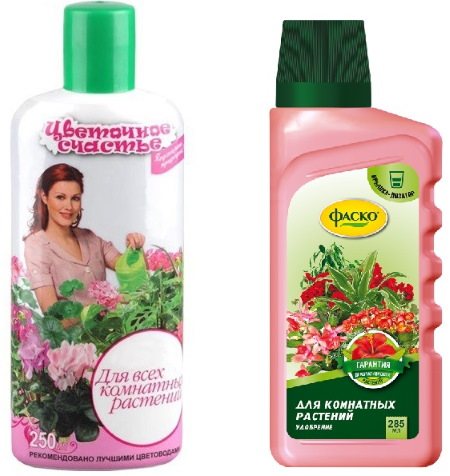

Homemade begonia planted in a nutrient medium does not need feeding for several years. Fertilizers begin to be applied when the soil is clearly depleted. Apply complex ready-made dressings for flowering plants from the beginning of May to the end of October. In winter, Ivan da Marya is not fed.
Transfer
The plant is moved to a new container only when it is necessary to replace the soil or overgrowth of the roots. The procedure is best done in the spring, before the phase of active growth. Mariannik does not tolerate a transplant, so it may not bloom in the current season. The fragile roots of the plant are moved carefully, their damage greatly weakens the bush, leading to soreness or death of begonia.
Pruning
Ivan da Marya bushes do not need special pruning or shaping. It is enough to remove withered leaves, to shorten the outgrowing shoots. Pruning is mainly done to obtain green cuttings, if necessary, propagate begonias.
Temperature and humidity
Ivan da Marya is a thermophilic flower and dies in its natural environment during the first frost. Home begonia prefers moderate heat during the growing season.
It is advisable to grow the mariannik at a temperature of 18 to 20 ° C, reducing it to 15 ° C in the cold season. The plant adapts well to any air humidity. Year-round flowering occurs even when it is impossible to provide the bushes with ideal conditions. It is enough to keep the soil moist, loose.
What does a plant look like
The Ivan da Marya flower is a herb that is found in meadows and glades. It can be seen near bushes, on forest edges, near swamps. He has many names among the people: sister and brother, jaundice, Ivan-grass and many others.
The stem of the plant is straight, covered with white hairs. All flowers are arranged one by one on the legs, turned to one side. Where yellow flowers are located on Ivan da Marya, there is a blue leaf.
After flowering, the fruit ripens, which looks like a grain. They are collected by ants and transferred to other places. Because of this feature, the plant is often found along ant paths.
Flower: description and other names
This plant can bear different folk "names", such as jaundice, yellowberry, Ivan's grass, lime-tree, well-aimed grass, meadow bell and Ivan da Marya. But these are not all names, since this herb has attracted the attention of many people over the years, who happily gave it new "nicknames". But scientifically, it is called as the oak-tree oak from the genus oak-tree, the norichnikov family. But among the people, the name Ivan da Marya has generally stuck.
The flower is annual and can grow from 15 to 60 centimeters. Its stems are down, the leaves are pointed, green. Flowers of bright yellow color are collected in several inflorescences, each of them has a two-humped, irregular shape. The flowers are decorated with purple toothed bracts. After flowering, a small egg-shaped fruit appears. In the capsule, oblong seeds ripen and acquire a brown, almost black tone. They are food for wild game. Due to the abundant secretion of nectar, the flower belongs to the honey plant.
Is it possible to grow in the country
Recently, due to its decorative qualities, Ivan da Marya is used by landscape designers to create pastoral images in their summer cottage... Alpine slides are decorated with it. A small clearing of bright colors adds uniqueness to the site. Sometimes used to create borders in flower beds. It looks very picturesque. However, many gardeners are wary of placing the plant on their territory due to its parasitic properties and rapid spread.
The plant world is large and varied. Some are a decoration, others treat and help in solving everyday problems, others combine several amazing qualities at once.... The nature that created this magnificent palette of colors, properties and fragrances is an unrivaled creator. We continue to admire her talent for centuries.
Date of publication: contraindications
The story of Kupala and Kostroma
Another legend tells of loyalty and love. It tells about how on the day of the summer solstice he saw the goddess Bather. They had children: Kostroma and Kupala.
Once geese-swans flew by and stole Kupala, carried away to distant lands. Years have passed. One fine day Kostroma was walking by the river, wearing a wreath on her head. She told her girlfriends that no one would ever be able to pluck a wreath from her head. For these words, the gods were angry with her, the wind tore off the wreath and carried her into the river. According to custom, the girl should get married with the one who picks up the wreath. At that time, Kupala sailed past the wreath and caught the wreath. They got married and only after the wedding the young people found out that they were brother and sister, but had already managed to fall in love with each other. In order not to part, Kostroma and Kupala decided to drown themselves. The gods had mercy on them and turned them into the Ivan da Marya flower, so that they would always be together.
Infusion recipes
If you have scabies, rashes, or scrofula, a decoction can be prepared and added to the bathroom or used for topical wiping. For cooking, you need to pour three tablespoons of herbs with a liter of boiling water. You need to insist for two hours, after which the product is filtered.
If a person has dizziness, hypertension, epilepsy, heart disease, neuralgia, problems with the gastrointestinal tract, another infusion is prepared from the same herb. For preparation, a glass of boiling water is poured into a container with a tablespoon of oak mariannik. After half an hour has passed, the product is filtered. You need to take half a glass twice a day.
In order to heal wounds faster, you can use fresh milled grass. Powder from Ivan da Marya has the same effect.
If you need to get rid of harmful insects, a decoction of the fruit is prepared.
Plant symbolism
Ivan da Marya is one of the main symbols of the holiday of Ivan Kupala, a sign of unbreakable love.
In addition, it is believed that yellow symbolizes fire, and purple - water (dew). Thus, ivan da marya is a symbol of the unity of opposites, a sign of fire and water.


There are religions in every corner of the world whose teachings are based on herbal magic. Both sorcerers and modern doctors claim that plants have energy and healing properties that have not yet been studied by man. One of the most mysterious herbs is ivan da marya.
Our ancestors did not know about doctors and pills. But they improved their health with the gifts of nature. The newborns were bathed in decoctions, the girls washed themselves with spirit water for beauty, and the sick were given tinctures for better health.
Of course, with progress, some of the knowledge was forgotten forever. But still, some information has survived to this day. Today herbs help to improve health, cleanse the body and even attract good luck or win the heart of a loved one.
Ivan da Marya belong to the paraphyletic group of plants. The people also call this flower adam-i-eva, lungwort, brother and sister, yellowberry, honeydew, fireflower, oak mariannik, jaundice, ivanova grass, meadow bell.
One beautiful but tragic story is associated with this plant.The legend says that once upon a time there lived a brother and sister - Ivan and Marya. Fate separated them in childhood. Many years passed and relatives met. The guy and the girl immediately fell in love and even decided to get married. Then the terrible secret of their relationship was revealed. In order to never part, young people turned into a beautiful flower. According to another version, it was the Lord's punishment for the fact that blood relatives got married. Purple and blue represent the guy's shirt, and yellow represents the girl's scarf.
The Slavs believed: if you pick flowers at night, the plant will protect your home from harm throughout the year. This herb drives away evil spirits, protects the family and increases love between a man and a woman.
Grass is harvested in summer, during the flowering period. The leaves are dried in the open air. You can meet this specimen in the fields and in light forests. The plant is widespread in the European part of Russia, in the steppes of Ukraine and in the Caucasus. Keep the herb away from other medicinal plants. Shelf life 10 months.
Ivan da Marya helps with inflammation. With the help of lungwort, wounds are healed. It is also used for headaches, stomach ailments and skin problems.
Bath tinctures are made from this specimen. To do this, take 3 tablespoons of chopped, dried herbs and pour 1 liter of boiling water. The liquid must be infused for at least two hours. Then the wounds are washed with broth. Heals the plant and epilepsy. 1 spoonful of herbs is poured with a glass of hot water and left to infuse for half an hour. Then they filter and drink one spoonful several times a day.
But you have to be very careful. Incorrectly prepared grass, may contain toxic substances.
Software content:
To acquaint children with the flower (name, appearance, places and features of growth). To teach children to understand the figurative meaning of the legend (from the book by L. Zgurovskaya "August in the Crimea"). Dictionary: Ivan da Marya, honey plant. Develop imaginative perception, the ability to see the beauty of nature. Foster interest and respect for nature.
Equipment:
Pictures depicting a flower.
Ivan da Marya
Course of the lesson:
There are many legends about the origin of flowers. Today you will hear a legend about a flower with an amazing name - Ivan da Marya.
Reading the legend.
The legend of Ivan da Marya
“A long time ago, Leshy lived in a dense forest. Bow-legged, with hooves, eared and very curly disheveled. People thought so. The goblin himself said that he was shaggy because in his hairdressers he had all sorts of woody thorns through which he constantly struggled in the forest. Well, so, the Leshy lived for himself. He lived in his own way, grieved in his own way and rejoiced in his own way. He was not afraid of loneliness, he had no friends, he did not know what love was, he fought with rivals, drove them out of the forest. So it would have gone on, but suddenly Leshy fell in love. Once in the spring I saw a little yellow-eyed violet under a bush - Maryushka, and the little man disappeared with all his uncombed curls and hooves. He settled down next to him, stares and sighs, sighs, well, just like a patient. It was he who was gaining courage. Violet stands, blooms, flaunts, does not even look at Leshey. Goblin was upset, take it and blurt out: "I am fascinated by you, life without you is no good, marry me." Violet looked at Leshy and turned away. Goblin thinks: how to surprise her, and let's brag: "I can do that, I can do that, do you want all the stars in a hat?"
Violet Maryushka again looked at the disheveled admirer and said: “Why do I need stars in a hat? Let them live in heaven, they shine on the forest paths for me and my betrothed. I love Ivan, I will live with him, not with you. " It was she who spoke so for the purple Ivan blooming nearby.
The time has come, two violets, yellow and purple, got married, and healed together in one house, one flower. In the flower there are yellow petals - Maryushka, and purple ones - Ivanushka.And there was neither Maryushka nor Ivanushka in the forest separately, but there is a single forest flower Ivan da Marya. And the Leshy still staggers in the forest, grieves and complains to everyone. "
Ivan da Marya is a forest flower. What does it mean? This flower grows in the forest.
The flowers of Ivan da Marya exude abundant nectar and are deservedly considered a good honey plant. Do you know what plants are called honey plants? Listen to this word - "honey plant", what does it mean? Honey carries.
The flower Ivan da Marya adapted very interestingly to the spread of seeds - ants help him in this. The fact is that seeds, similar to wheat grains, have a bag of aromatic oils. For ants, these oils are a delicacy, and therefore they drag the seeds. And that's all the flower needs.
And this flower is also interesting in that it has suckers on the roots that attach to the roots of other plants. So the flower is fed with the sap of foreign plants.
This flower is poisonous! It also has medicinal properties: heals wounds, heals the heart and skin.
Just think, a small flower, and how many people need it: seeds for ants, pollen for bees, tinctures from leaves for medicine for people. And it’s nice to just look at the flower. Take care of the beauty of children, do not pick flowers. Forest flowers do not live when plucked in a vase, but immediately wither and die.
If I pick a flower ...
If I pick a flower, If you pick a flower ... If everyone: both me and you - If we pick flowers, Then the trees and bushes will be empty ... And there will be no beauty. And there will be no kindness. If only you and me - If we pick flowers ... (T. Sobakin)
Questions:
1. Why did the flower get this name? 2. What color is it? 3. Where does Ivan da Marya grow? 4. Why is this flower called "honey plant"? 5. Why do ants love the ego? 6. How is it fed with sap of other plants? 7. Can Ivan da Marya be called a medicinal plant? Why? 8. Why can't you pick this flower?
The memorable name of the flower Ivan da Marya is known to many. It has long been a symbol of love and fidelity.
... The bright color makes it noticeable, and the medicinal properties of the plant contribute to a fairly widespread use in folk medicine.
The herbaceous annual has a lot of other, everyday names. Ivan's grass, jaundice, lime-tree, all these are the names of one plant. The botanical name of the flower is oak mariannik, belongs to the Norichnikov family
... Often found in meadows, forest glades and forest edges. It receives useful substances from the soil, air and by sucking on neighboring grasses. Seeds are often carried by ants.
Maryannik Dubravny (Ivan da Marya) - annual flower
After flowering, large black seeds appear in a small egg-shaped capsule
, which often serve as food for birds. It is the seeds that are especially poisonous.
The plant is poisonous. It must be used with caution.
Possible diseases and pests, ways to get rid of them
Begonia does not tolerate prolonged waterlogging of an earthen coma, which provokes rot, fungal infections. Most often, the plant suffers from powdery mildew.
The first signs of such lesions appear on the lower leaves in the center of the bush. Diseased leaves are immediately removed, completely stop watering for several days, and also reduce them later. These techniques are enough to stop the disease.
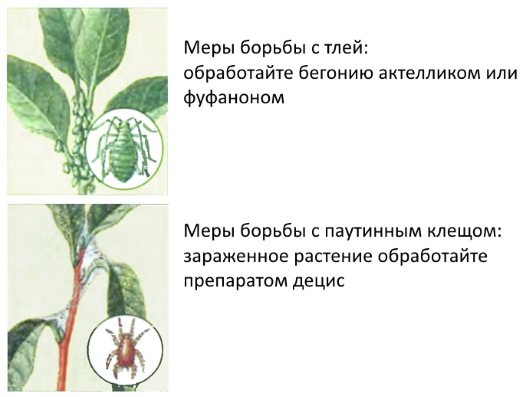

From pests, begonia can be attacked by aphids or red spider mites. It is recommended to deal with them with special insecticides for indoor plants. Traditional methods in the form of soap washes or other water procedures are harmful to the green part of Ivan da Marya.
Warning
Anyone who decides to use the Ivan da Marya flower for treatment needs to remember that it is poisonous, so it is important to exercise caution, especially when taking the plant internally. The seeds contain aucubin.It is capable of acting as a narcotic and also irritating. This is usually expressed in drowsiness, decreased heart activity and weakness. If, after using this drug, you notice the listed symptoms, you should immediately consult a doctor.


